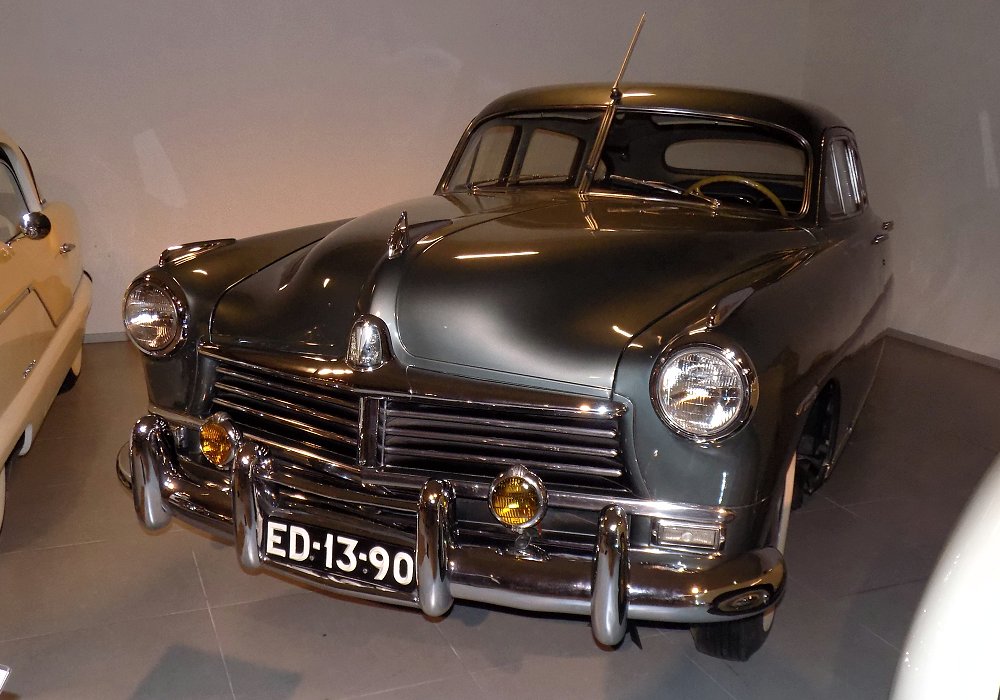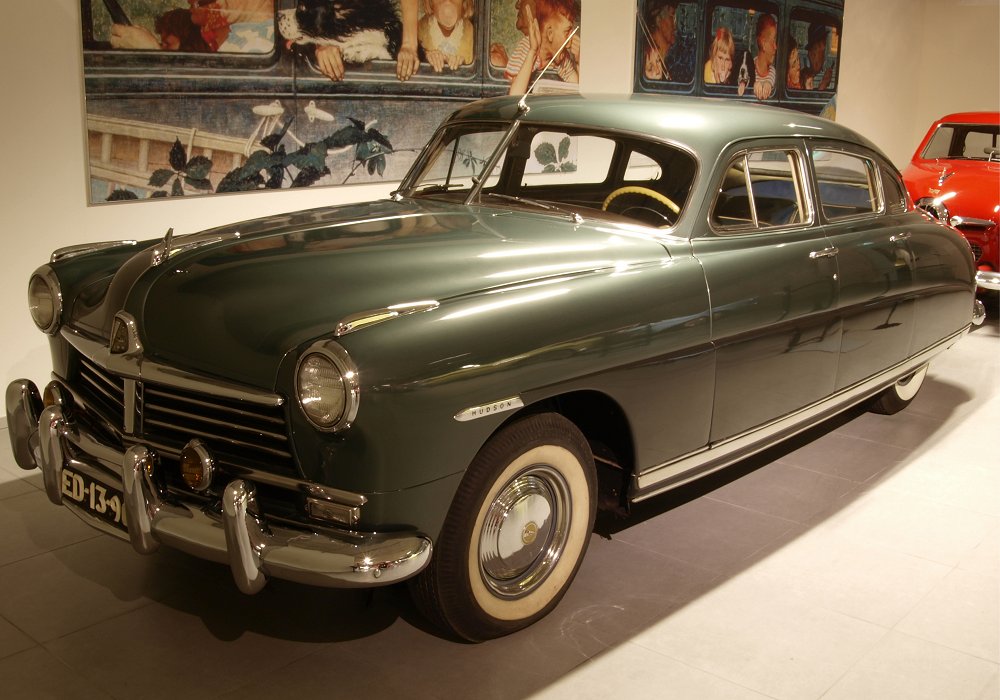Description
The Hudson Commodore Eight 484 Sedan was one of the most refined and advanced American automobiles of the late 1940s—a car that perfectly captured the engineering brilliance and quiet sophistication for which the Hudson Motor Car Company had become known. Introduced as part of the 1948 model lineup, it marked the debut of Hudson’s revolutionary “Step-Down” design, a construction technique that redefined automotive architecture and earned Hudson a permanent place in the history of modern car design. The 484 Sedan, with its long wheelbase, powerful straight-eight engine, and beautifully balanced styling, stood as the pinnacle of Hudson’s craftsmanship and ambition.
When Hudson unveiled its 1948 range, the world took notice. After years of conservative postwar retooling by other manufacturers, Hudson dared to launch an entirely new kind of automobile—one that sat lower, handled better, and looked unlike anything else on American roads. The Commodore Eight 484 Sedan was the flagship of this new generation. Its name reflected both its prestige and configuration: “Eight” denoting the smooth, long-stroke straight-eight engine that powered it, and “484” identifying its body and wheelbase series within the Commodore range. The car’s design was low and sleek, yet substantial and dignified, projecting a modern confidence without resorting to ornament or excess.
At the heart of the Commodore Eight 484 lay Hudson’s proven 254-cubic-inch inline eight-cylinder engine, an advanced side-valve unit producing 128 horsepower and abundant torque. The engine was a masterpiece of smoothness and balance, the result of Hudson’s long experience with straight-eights dating back to the 1930s. The long crankshaft turned effortlessly, delivering its power with calm, silken precision. Unlike the high-strung overhead-valve engines of some rivals, Hudson’s eight was designed for endurance, quietness, and tractable strength. Its performance was perfectly matched to the Commodore’s character: effortless, steady, and unhurried, capable of high cruising speeds without strain. The standard three-speed manual transmission, optionally fitted with electric overdrive, made highway travel nearly silent, the car gliding along with the engine scarcely above idle.
What truly distinguished the 484 Sedan, however, was its structure. Hudson’s “Step-Down” construction, patented and introduced in this model year, integrated the frame and body into a single semi-unitized shell. Instead of placing the passenger floor above the frame rails, Hudson engineers recessed it inside them, effectively lowering the entire passenger compartment several inches closer to the road. This not only gave the car its distinctive low silhouette but also lowered its centre of gravity dramatically. The benefits were profound: the Commodore Eight handled with a stability and precision that astonished both owners and automotive journalists. It cornered flatly, resisted side-sway, and inspired confidence even at high speeds. For a large American sedan, it was nothing short of revolutionary.
The “Step-Down” design also enhanced passenger safety. By surrounding the occupants with a strong box-section frame integrated into the body, Hudson created what was, in effect, an early form of safety cell. Passengers sat within the car rather than on it, lending both a sense of security and a comfortable, enveloping seating position. The car’s low entry height and wide doors made ingress and egress easy, while the deep floorpan provided exceptional legroom and a natural seating posture. Hudson engineers had achieved the rare feat of combining structural rigidity, safety, and comfort in one elegant solution.
The suspension system further complemented this advanced design. Independent front suspension with coil springs and hydraulic shock absorbers ensured a smooth, well-controlled ride, while the rear employed semi-elliptic leaf springs that balanced comfort with durability. Hudson’s hydraulic brakes—large and finely modulated—offered confident stopping power, and the car’s steering, though unassisted, was light and precise once underway. Contemporary testers praised the Commodore Eight for its uncanny ability to maintain composure over rough roads and during quick directional changes. It felt sure-footed and poised in a way that few American sedans of the era could match.
Aesthetically, the Commodore Eight 484 Sedan was a triumph of proportion and restraint. Its bodylines were clean and continuous, free from the clutter of excessive chrome or ornamentation that marked many of its contemporaries. The long hood flowed into gracefully integrated fenders, while the cabin itself sat low and wide within the car’s sweeping contours. The broad grille—dominated by horizontal bars and framed by rounded headlamps—gave the front end a strong yet understated identity. Chrome accents highlighted the beltline and window frames, while the rear was distinguished by a smooth taper and simple, well-balanced taillamps. The effect was one of quiet authority: a car that radiated craftsmanship and confidence rather than ostentatious display.
Inside, the 484 Sedan continued Hudson’s tradition of refined luxury. The interior was spacious, beautifully upholstered, and finished with meticulous attention to detail. Seats were deep and inviting, covered in fine broadcloth or optional leather, and thick carpeting extended from sill to sill. The dashboard featured sweeping curves finished in lacquer or simulated woodgrain, with round, clearly legible instruments set within chrome bezels. The steering wheel was large and elegant, and all controls were placed for easy, intuitive operation. Optional equipment included a push-button radio, clock, heater, and overdrive unit—all integrated harmoniously into the car’s design. The Commodore Eight was as much a car to be admired from within as from without: quiet, serene, and exquisitely made.
Driving the Hudson Commodore Eight 484 Sedan was an experience that left a lasting impression on those fortunate enough to sample it. The straight-eight engine delivered its power in a smooth, unbroken surge, and the car’s low stance made it feel planted and secure at any speed. On highways, it glided effortlessly, the engine barely audible above the rush of air, while on winding roads, it responded with agility rare in a car of its size. The ride quality was supple yet controlled, the structure solid and free from the rattles that plagued many body-on-frame competitors. It was, in every sense, a car that felt decades ahead of its time.
The Commodore Eight 484 Sedan found a devoted following among professionals, executives, and discerning motorists who valued precision and integrity over flash and size. While Cadillac, Buick, and Packard competed on chrome and horsepower, Hudson’s appeal lay in its engineering excellence and honesty of design. The company’s advertising proudly declared, “America’s Safest Car—America’s Best Road Car,” and few who drove one could disagree. The car’s combination of low stance, advanced structure, and impeccable road manners made it one of the finest-handling American sedans of its era.
By 1950, the Commodore Eight had become a symbol of Hudson’s golden age. It represented a company at the peak of its technical prowess, producing cars that were not merely stylish or powerful but fundamentally well-conceived. The innovations that defined the 484 Sedan would later form the foundation for the Hudson Hornet’s racing dominance, proving that the same design principles that made for comfort and safety could also yield performance and agility.
Today, the Hudson Commodore Eight 484 Sedan stands as one of the most significant American cars of the immediate postwar period. Collectors and historians admire it not only for its beauty but for its technical importance—the car that introduced the world to the Step-Down principle and set new standards for handling, safety, and design integrity. Restored examples reveal the precision of Hudson’s craftsmanship and the timeless grace of its proportions. To drive one is to experience a moment of quiet triumph in automotive history: the feeling of power delivered through refinement, of innovation achieved through intelligence rather than extravagance. The Commodore Eight 484 Sedan remains a masterpiece of American engineering and a testament to Hudson’s enduring belief that true luxury begins with excellence in design.


